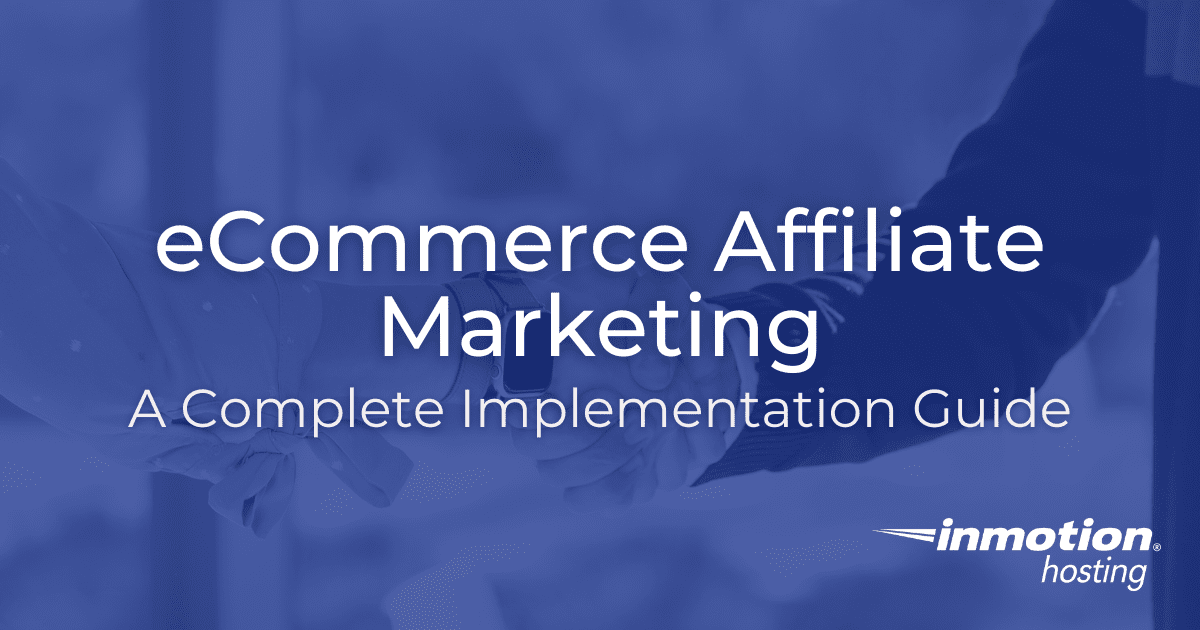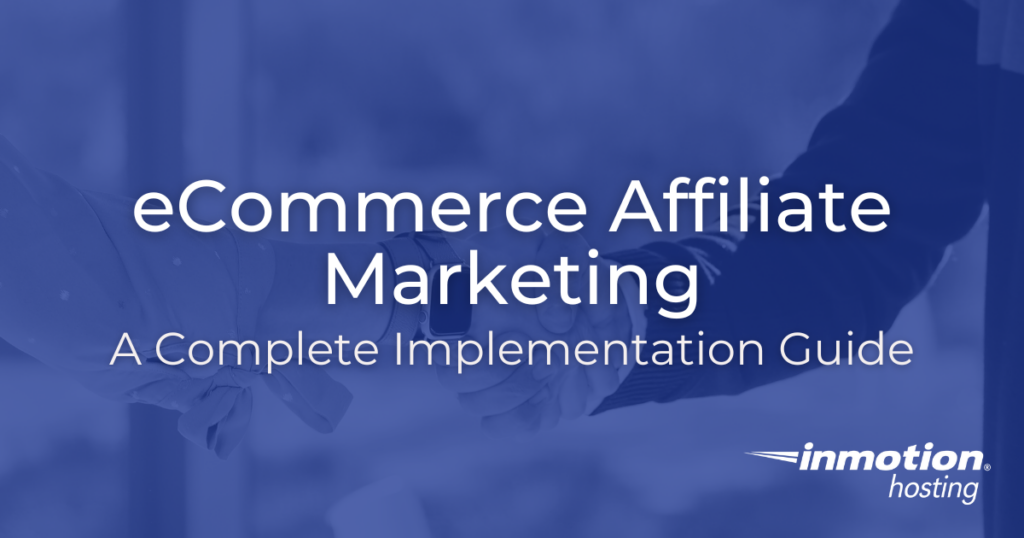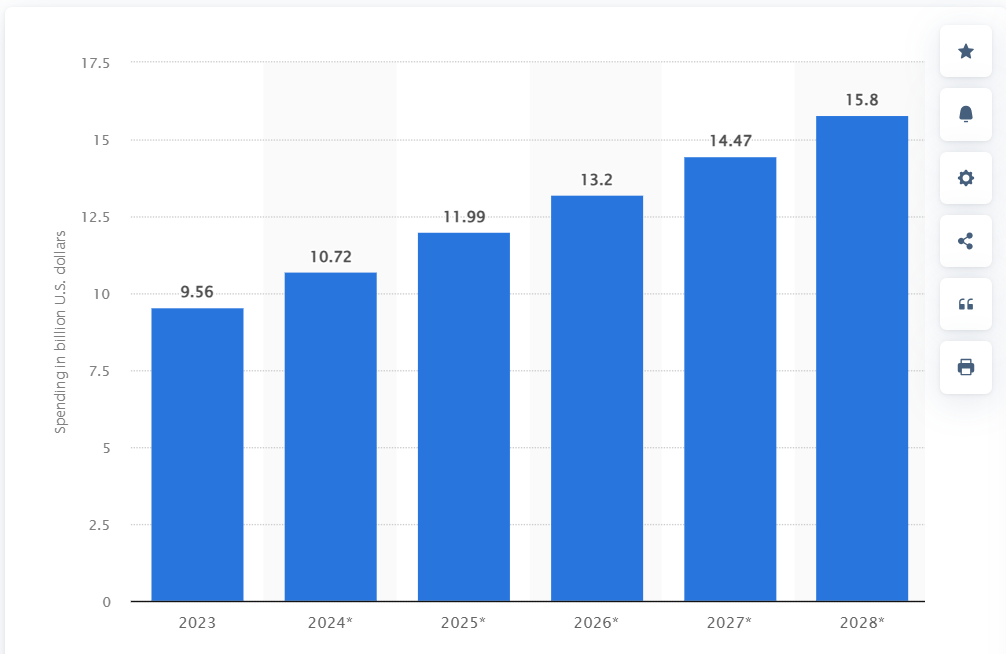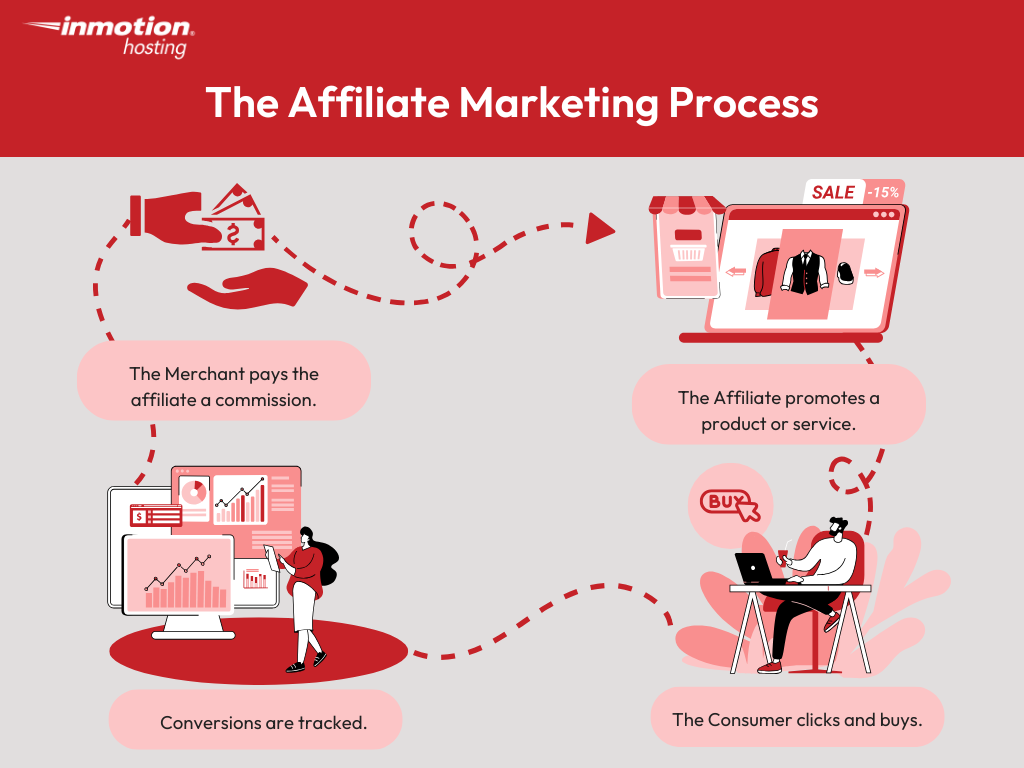

eCommerce affiliate marketing is one of the ideal strategies for promoting business growth and driving online sales. Research done by Statista disclosed that the affiliate marketing industry was valued at an estimated $9.56 billion in 2023, which is anticipated to reach $10.72 billion in 2024 and $12 billion in 2025[1].
These statistics underscore the significant impact of eCommerce affiliate marketing on the digital marketing landscape. The illustration below shows the affiliate marketing spending in the United States from 2023 and its projection in 2028.

Whether you’re a beginner in eCommerce affiliate marketing or looking to expand your affiliate eCommerce space, understanding all the intricacies of affiliate marketing for eCommerce is a must.
Affiliate marketing for eCommerce is cost-effective, increases brand exposure, and enhances substantial revenue streams as a marketing strategy. This guide delves into best practices, technical requirements for affiliate marketing, best affiliate programs, and security and compliance considerations.
Let’s get started!
What is eCommerce Affiliate Marketing?
eCommerce affiliate marketing is a marketing strategy wherein a retailer, also known as a merchant, rewards partners or affiliates for generating sales or driving traffic to their sites through affiliate links.
Have you seen headings on blogs marked “affiliate link” or “sponsored post?” That would be considered an “affiliate link”.
Partners often include influencers, bloggers, or various websites that promote a merchant’s product through ads or links on their platforms, including social media. This earns a commission when someone purchases through their referral links.
The US is currently a global lead in affiliate marketing. Six percent of their orders are through affiliate links[2]. ECommerce marketing in the United States is anticipated to grow at a CAGR of 8.99% in the next few years.
The table below illustrates yearly eCommerce sales in the United States:
| Year | US eCommerce Sales | Change from Previous Year |
|---|---|---|
| 2020 | $807.1 billion | +41.7% |
| 2021 | $950.5 billion | +17.8% |
| 2022 | $1,012.2 billion | +6.5% |
| 2023 | $1,102.2 billion | +8.9% |
| 2024 | $1,223.0 billion | +10.95% |
The above marketing strategy functions on a cost-per-action model. This means eCommerce affiliates are paid based on the following:
- Clicks
- Sales
- Leads generated from the referral links.
Since it can be difficult to understand affiliate marketing well as a small business owner, here is the eCommerce affiliate marketing process:

Key Differences Between Marketing Channels
With a plethora of marketing channels across the internet, it can be confusing to understand how each marketing channel works. This section will help you acquaint yourself with different marketing channels, including social media marketing, paid ads, and content marketing, and how each differs from e-commerce marketing.
This table highlights the difference between eCommerce affiliate marketing and other marketing channels:
| Marketing Channel | eCommerce Affiliate Marketing | Social Media Marketing | Content Marketing | Paid Advertising |
| Cost Structure | Performance-based (CPA) | Pay per post/campaign | Cost of content production | Pay-per-click (PPC |
| Payment Model | Commission-based (sales or leads) | No direct sales commission | No direct sales commission | Payment for clicks or impressions |
| Risk | Low risk (pay only for results) | Medium risk (uncertain ROI) | Medium risk (requires organic traffic) | High risk (ad spend could be wasted) |
| Effectiveness | High (if affiliates are well-targeted) | Depends on engagement and targeting | Depends on content quality and SEO | It can be immediate, but long-term ROI may be uncertain |
Summary: The main and noticeable difference between eCommerce marketing and other marketing strategies is the cost structure. In affiliate marketing, partners are only paid when there is a sale, making it a low-risk form of marketing strategy.
Components of Successful Programs
Running a successful eCommerce marketing campaign entails putting proper strategies and components in place. Here are the crucial elements you should consider when building your campaign:
- Selecting the Right Affiliate Program
Different affiliate networks have different policies, meaning that not all programs fit your brand’s mission and vision. It is crucial to find a program that matches your needs. This will help you drive higher sales and traffic simultaneously.
- Effective Tracking
Proper tracking is another effective component of successful eCommerce marketing. By strategically tracking and using analytic tools, you can measure each affiliate link to see its sales stats, traffic, and conversions.
- Proper Optimization
Proper and ongoing optimization of your affiliate links is a significant component in running a successful eCommerce marketing campaign. Affiliate marketing is not something you just set, forget, and wait to earn a commission on.
“A quality affiliate program is backed by a dedicated affiliate support team – make the most of their expertise, particularly for tracking link implementation. Your Affiliate Manager can provide specialized tracking links that direct to specific product pages.
Also, inquire about dedicated landing pages for affiliate traffic. This is crucial since companies often conduct A/B tests on their homepage, which can affect conversion rates. A separate landing page for affiliate traffic helps insulate your conversions from these testing variations.”
— Derrick Hernandez, InMotion Hosting Senior Affiliate Marketing Manager
Businesses must constantly optimize their affiliate links to monitor their affiliate performance, test different methods, refine old and unproductive strategies, and offer better feedback to optimize the link for the program’s success.
Technical Requirements for Affiliate Marketing
Running a successful affiliate marketing program requires more than collaboration and marketing methodologies. Technical requirements such as solid infrastructure, performance, and traffic are also a must.
Below are essential technical requirements for affiliate marketing you must know as a small business owner:
Server and Infrastructure
Reliable hosting infrastructure is the cornerstone of an eCommerce affiliate marketing program. When you’re handling a website with high traffic, a few seconds of page load time can lead to a significant loss of affiliate traffic and sales, resulting in a poor user experience
Accelerate your website performance with InMotion VPS solutions, featuring NVMe drives and optimized server configurations designed for high-traffic websites. Our VPS solutions come with NVMe drives and optimized server configurations specifically designed for high-traffic websites.
A quality server setup ensures that your website is visible 24/7, secure, and capable of managing both high and low traffic simultaneously.
Performance Optimization Essentials
A poorly optimized website can frustrate potential customers and users, hurt your website’s SEO rankings, and send clients away. To run proactive eCommerce affiliate marketing, the following key performance optimization essentials are a must.
1. Mobile Optimization
A study by Statista shows that almost 59% of global website traffic comes from mobile devices[3]. This means that you cannot ignore the power of mobile optimization if you want to have successful affiliate marketing in 2025.
Mobile responsiveness is mandatory for any affiliate website. In this case, Google Search Console’s Mobile-Friendly Test is the most suitable tool to ensure all your pages are optimized for smaller screens.
2. Create Well Researched and Informative Content
It is said that “content is king.” But without proper research and incorporating best SEO practices, content risks losing its mantra. Your affiliate content needs to be SEO optimized, quality, and answer users’ queries directly.
Ensure to conduct proper research on the targeted keyword. Tools like SEMrush, Google Keyword Planner, and Ahrefs can help you identify a low-hanging keyword with great potential to rank on SERPs.
3. Select the Right Niche
The best affiliate SEO marketing strategy begins with niche selection. “Before jumping into affiliate marketing, spend time choosing a niche first. Once you decide on your niche, you must be consistent with it. Upon providing value to the customers in a certain niche, you will steadily grow in that domain– leading to long-term success in affiliate marketing.”- Source: ClickAdu.
4. Image Optimization
Image optimization improves user experience, website performance, and search engine rankings. Generally, high-quality and optimized images are crucial for creating curiosity, which can lead users to click on them for more insights.
Use tools like ShortPixel or TinyPNG to reduce large file sizes, which can ultimately slow down page loads and lead to customer dissatisfaction. By using image optimization tools, you can create a balance between performance and quality.
Bandwidth Considerations
Bandwidth refers to the amount of information or data your server can comfortably handle over a certain period.
This technical requirement for affiliate marketing plays a pivotal role in eCommerce marketing, especially during holiday promotions, seasonal marketing events, and flash sales when traffic is at its peak. Sufficient bandwidth ensures your website can manage a sudden increase in traffic without slowing down or crashing.
Here is an example of bandwidth requirements for affiliate sites.
| Website Traffic Volume | Monthly Bandwidth | Recommended Hosting |
|---|---|---|
| Low (10,000 visitors/month) | 10–50 GB | Launch Plan |
| Medium (50,000 visitors/month) | 100–500 GB | Power Plan |
| High (100,000+ visitors/month) | 1 TB+ | Pro Plan |
Base Technical Setup Checklist
A proper and well-organized technical setup ensures your eCommerce marketing program functions effectively. The following must be included in your affiliate marketing program as your base technical setup;
Hosting and Infrastructure: Select the best hosting plan with the best scalable bandwidth and 99.9% uptime. Similarly, your hosting provider must be aligned with SSL certificate policies for effective transactions.
Use Affiliate Tracking Software: Track your affiliate activity using Post Affiliate Pro or Tapfiliate to see your affiliate performance report.
Use Monitoring and Analytics Tools: You can install Google Analytics to help you track your performance behavior. Additionally, the UptimeRobot tool helps you monitor server uptime.
Security Measures: Regular plugins and CMS updates are some of the best technical setups for your affiliate marketing program. This helps prevent unforeseen vulnerabilities.
Compliance with Affiliate Policies: When setting up your eCommerce affiliate program to track users’ information, you must follow GDPR compliance. Also, ensure that you include terms and conditions to guide users through your affiliate program.
Top 4 Popular Affiliate Program Types in 2025
As technology advances, so does eCommerce marketing. Affiliate marketing continues to snowball, offering many opportunities for small businesses and both beginners and professional marketers to earn a living.
Below are some of the popular affiliate program types you may want to delve into in 2025:
1. Blogging
Influencer Marketing Hub disclosed that 25% of retailers are in partnership with affiliate bloggers[4]. This reveals the huge growth of blogging as an affiliate marketing program. As social media is dominating the affiliate space, blogging will also become popular in 2025.
In this affiliate program, bloggers primarily select a particular niche, specialize in it, and share products or services with their followers or audience. For example, a health blogger writes about health products and their benefits and shares them with their audience while providing an affiliate link to a product in the post.
Check out this example from Ricky Kesler of Income School. In addition to using their website to educate and offer blogging training, they earn money through an affiliate marketing program.

2. Influencer Marketing
Influencer marketing is different from eCommerce affiliate marketing. This type of marketing is all about building brand visibility, awareness, and credibility, whereas eCommerce marketing is more focused on income generation.
However, influencers can share affiliate links with their audiences to earn a commission from the sale. One plus for working an affiliate program in tandem with influencer marketing is that they usually have a strong social presence already, adding some trust to your affiliate links.
3. Social Media Sites
Search Engine Optimization (SEO) is the leading marketing strategy used by many affiliate marketers, followed by social media. Research conducted by Optinmonster shows that 67% of marketers use social media sites to connect with their customers[5].
It is easy to open social sites such as Instagram, Facebook, Twitter, and LinkedIn to kick off your affiliate campaign. Unlike blogging, where some fees are incurred, Facebook can help you showcase your products and share the links with your followers.
4. Email Marketing Partnerships
Affiliates with a huge email following list are the best at promoting affiliate products or sharing links with a trusted number of audiences.
Email marketing can help you share valuable content with a warm and interested audience. You can make personalized recommendations, draft enticing newsletters, and provide exclusive offers to engage your followers.
Benefits of email marketing:
- High return on investment
- Direct access to a particular audience
- Allow for personalized recommendations or promotions.
Pro tip: Email marketing requires you to comply with email marketing regulations such as CAN-SPAM, GDPR, etc. Over-promotion of affiliate links bores your audience, making them unsubscribe from your email list.
Affiliate Program Payouts-All You Need to Know
Choosing the right affiliate program payout is another important step. The following things must be taken into consideration before choosing an affiliate payment model:
- Business goals
- Affiliate expectations
- Industry standards
Here is a comprehensive breakdown of the popular affiliate payout structures on the market today.
1. Direct Sales Models
Direct sales models, also known as commission-per-sale, are largely used in retail businesses and eCommerce. In these models, partners earn a certain amount of commission based on the product value each sale produces. The average commission rate is typically 5% to 30% of the product sale value.
The table below shows the fixed standard commission rate for Amazon Associates.
| Product Category | Fixed Commission Income Rates |
|---|---|
| Luxury Beauty, Luxury Stores Beauty, Amazon Explore | 10.00% |
| Amazon Haul | 7.00% |
| Physical Books, Kitchen, Automotive | 4.5.% |
| Digital Music, Physical Music, Handmade Digital Videos | 5.00% |
2. Pay-Per-Lead (PPL) Structures
A pay-per-lead structure is well-known in industries such as insurance, B2B, and finance, where the sale cycle tends to be longer. In this model, partners earn commissions when they drive targeted leads to a particular product or service. A client doesn’t need to complete a purchase for you to earn a commission.
You can earn $5 to $50 per lead, depending on the field you’re participating in.
Here are some industry standards for PPL structures:
| Industry | Payout Per Lead |
|---|---|
| Careers | $4.05 |
| Construction | $8.14 |
| Art/Entertainment | $4.20 |
| Education/Training | $11.83 |
| Insurance | $8.40 |
| B2B Software | $20 – $250 |
3. Click-Based Compensation (CPC)
If you’re looking for an affiliate payout model where you’ll earn revenue based on the number of clicks you generate, click-based compensation is a good fit. This payout structure operates on a cost-per-click (CPC) model and is suitable for sources with high traffic.
A click-based compensation model is best for blogs, content publishers, and comparison sites, among other things. For instance, Google AdSense pays publishers per click. Rates always differ depending on the industry and niche competition.
Security and Compliance Considerations for Affiliate Marketing
A secure and compliant affiliate program protects both your affiliate channel and your business, ensuring a high return on investments. Fraud, cyber threats, and data privacy violations not only harm your website but cause financial losses.
Consider these security and compliance factors for your affiliate marketing program:
SSL/HTTPS Requirements
Your affiliate program requires robust security measures to protect data transmission and build customer trust. SSL certificates provide:
- Encrypted data transmission between servers
- Enhanced SEO rankings
- Verified site authenticity
- PCI compliance support
SSL Certificate Benefits
- Improves search engine rankings through enhanced security protocols.
- Builds customer trust with verified site authentication.
- Prevents data interception with encrypted connections.
Protect your affiliate revenue with included SSL certificates and regular security scanning on an InMotion Hosting plan.
Data Privacy Compliance
To prevent legal penalties, any eCommerce marketing program must ensure it’s aligned with global internet regulations regarding data privacy, including GDPR (Europe), PIPEDA (Canada), and CCPA (California).
For instance, in 2021, Luxembourg data protection fined Amazon Europe €746 million for violating GDPR concerning their targeted ad practices, which was considered not to have received a genuine agreement from the users.
Fraud Prevention Measures
eCommerce fraud skyrockets yearly, costing businesses billions of dollars. Typically, professional fraudsters use loopholes in tracking systems to generate fake clicks, leads, ad hijacking, and cookie stuffing, which leads to flawed budgeting.
A recent research by Statista reveals the global cost of online advertising fraud would snowball from $88 billion to $172 billion within the next four years[6].
However, the following measures can be used to prevent fraud in 2025 and beyond:
- Use of advanced data analytics to spot uncommon patterns
- Performing regular audits
- Use of multi-factor authentication
- Creating informative blogs about fraud risk
- Keeping track of the transactions
- Conducting KYC (know your customer) protocols
- Fraud detection software
Secure Payment Processing
The following are the best practices for ensuring secure affiliate payment processing;
- Use well-established payment gateways such as Stripe, PayPal, Wise, and Payoneer.
- Use 2FA, Two-Factor Authentication, for your affiliate’s payout accounts.
- Use Anti-Fraud Filters to identify uncommon transactions.
- Be compliant with tax regulation
Setting Up Your Affiliate Program for Your Small Business
An organized affiliate program can result in an excellent ROI. However, to achieve the best of the best in your eCommerce marketing program, a business must carefully implement the following:
1. Platform Selection Criteria
Selecting the right eCommerce affiliate marketing program is the baseline for a successful affiliate program. The right affiliate platform primarily should do the following:
- Monitor and track affiliate marketing activities
- Offer marketing tools to help in link-sharing
- Automate payouts
- Support reputable payment gateway like PayPal
- It is designed with built-in fraud detection and is compliant with GDPR and other security measures
2. Commission Strategy Development
Select a commission structure that aligns with your profit margins, business model, and affiliate expectations. A well-organized affiliate commission strategy is essential for attracting and retaining affiliates with high-performance rates.
Here is a standard commission strategy for affiliate marketing:
| Model | How It Works | Best For |
|---|---|---|
| Pay-Per-Sale (PPS) | Affiliates earn a percentage of each completed sale. | eCommerce, SaaS, subscription-based businesses. |
| Pay-Per-Lead (PPL) | Affiliates earn when they generate qualified leads. | B2B, finance, insurance, SaaS. |
| Recurring Commissions | Affiliates receive ongoing commissions for subscription-based sales. | SaaS, memberships, online services. |
3. Terms and Conditions Essentials
Terms and Conditions (T&C) are another element to monitor in your affiliate marketing program. Typically, your affiliate Terms and Conditions act as a binding agreement that showcases your affiliate rules, guidelines, and expectations.
Key components in your affiliate Terms and Conditions are:
- Who can join
- Commission models
- Cookie duration and tracking mechanism
- Fraud prevention
- The type of content and brand usage
CMS-Specific Implementation Guide
A well-structured Content Management System (CMS) complements a high-performing eCommerce affiliate marketing program. To maximize affiliate conversion, your CMS should offer tracking, secure integrations, and a high-speed performance affiliate program.
WordPress Optimization Strategies
WordPress is the most well-known and widely used CMC globally by affiliate marketers. It is easy to customize, flexible, and comes with a varied plugin ecosystem. However, if your website is poorly optimized, it can harm your affiliate performance by slowing down due to high traffic and several tracking scripts.
The following explains how you can optimize your WordPress website for affiliate marketing:
Use a High Performing Hosting Provider
Hosting providers like InMotion WordPress Hosting offer optimized hosting, which includes pre-configured caching and dedicated resources to maintain fast load times, even with affiliate tracking enabled.
Use a Lightweight Theme
Design your website using lightweight themes such as Astra or Kadence. These themes are efficient and designed to load faster.
Plugin Selection and Compatibility
Plugins are also central to ensure fraud prevention, seamless tracking, and help in commission management. The following are some of the popular plugins along with their functions you can install on your affiliate website:
| Plugin | Functionality |
|---|---|
| AdSanity | Manage banner ads for affiliate promotions |
| Pretty Links | Shorten and cloak affiliate links. |
| AffiliateWP | Full-featured affiliate program management |
| ThirstyAffiliates | Manage and organize affiliate links |
| MonsterInsights | Track affiliate link clicks in Google Analytics. |
Database Optimization
A website should be maintained to facilitate faster website load. However, a slow page load can negatively impact your affiliate conversions. The following points will highlight how you can optimize your website database:
- Use cleanup plugins to remove redundant items such as spam content and unnecessary post revision.
- Consistently clean up the old affiliate tracking data
- Reduce the post revisions to 2 or 3.
WooCommerce Integration
If you’re running an eCommerce website with WooCommerce, effective integration is crucial for maintaining a high-converting and super-fast affiliate-loading page store. Here are the core WooCommerce optimization methods:
- Allow Ajax Cart Fragments removal
- Make use of LiteSpeed Cache (WooCommerce-friendly caching plugin)
- Lower the image load time
- Integrate affiliate websites with an affiliate management plugin like YITH WooCommerce to control referrals and commissions.
Improve the performance and security of your WooCommerce site with our new WooCommerce Hosting plans. Get 40x faster speeds for your online store with dedicated resources, server caching, and optimization tools.
High-Performance VPS
99.99% Uptime
Free SSL & Dedicated IP
Advanced Server Caching
Other CMS Considerations
For those affiliate marketers who are not using WordPress for their eCommerce marketing, here are other CMS platforms you can select for your e-commerce affiliate marketing program:
| CMS | Features |
|---|---|
| Shopify | Built-in affiliate apps, easy tracking |
| Magento | Scalable for large stores, advanced tracking |
| BigCommerce | Native integrations with affiliate networks |
| Drupal | It is highly customizable but needs developer setup |
SEO Impact and Management in Affiliate Marketing
SEO is the foundation of any successful eCommerce marketing program in 2025. A well-structured and SEO-optimized website ensures higher visibility in searches, better affiliate tracking, and higher rankings.
Here is the breakdown of the four aspects of SEO impact and management in Affiliate marketing;
Link Structure Optimization
Links play a monumental role in affiliate tracking and SEO ranking. Additionally, a well-structured and optimized link ensures search engines can effectively crawl your pages while maintaining equity in the site.
Below are the best practices for optimizing link structure:
Implement Flat URL Strategy
This includes the use of descriptive SEO-friendly URLs. For instance, example.com/product-name
URL Should Incorporate Main Keywords
This is another best practice for affiliate link optimization, where the target keyword is strategically placed in the URLs.
Additionally, you can use plugins, including ThirstyAffiliates, to redirect extended affiliate links into search engine-optimized URLs.
Duplicate Content Handling
Duplicate content can harm your website by confusing search engines. Affiliate websites struggle with duplicate product descriptions, multiple tracking, and syndicated content.
You can prevent duplicate content on your affiliate website by practicing the following;
- Rewrite the content and include the original research and value-added pieces.
- Use canonical tags to direct search engines to the target URL.
- Employ “NoIndex” meta tags for all the duplicate affiliate pages.
- Use Google Search Console to trace duplicate content on the site.
Authority Preservation
Long-term SEO success depends on the website’s authority on a particular topic. Google often favors high-quality and authoritative sites, protecting your domain authority and facilitating a productive e-commerce affiliate marketing program.
Here are some of the best practices to build website authority:
- Create well-researched, evergreen and informative content
- Boost your site’s E-E-A-T (Experience, Expertise, Authoritativeness, Trustworthiness). You can achieve this by including your article’s customer reviews, expert quotes, and credentials.
- Avoid excessive affiliate links on a post
Tracking Implementation Best Practices
Better affiliate commissions come with accurate tracking and SEO-friendly analytics. Conversely, poor tracking practices slow down website performance, hurt user experience, and attract SEO penalties.
Best Tracking Implementation Practices
- Boost your tracking accuracy and lower page load
- Make sure your pages can be crawled and indexed
- Use tracking tools in Google Analytics
Conclusion
Setting up a successful eCommerce affiliate program requires effective strategies that balance the choice of your commission structure, SEO optimization, compliance, and security considerations. By using the right affiliate marketing tools and best practices, businesses can primarily maximize their affiliate earnings.
If you’re ready to launch your affiliate program with the above strategy, start with a solid foundation using InMotion Hosting’s optimized hosting solutions for eCommerce and affiliate websites.
Improve the performance and security of your store with specialized eCommerce Hosting. Get faster speeds for your online store with NVMe storage, server protection, dedicated resources, and optimization tools.
99.99% Uptime
Free SSL
Dedicated IP Address
Managed Server
References
- “Affiliate Marketing Spend in the U.S. 2023-2028.” Statista, Sept. 2024, www.statista.com/statistics/693438/affiliate-marketing-spending/.
- Webster, Mark. “136 Affiliate Marketing Statistics in 2025.” Https://Www.Authorityhacker.Com, AuthorityHacker, 15 Nov. 2024, www.authorityhacker.com/affiliate-marketing-statistics/.
- “Share of Global Mobile Website Traffic 2015-2024.” Statista, Jan. 2025, www.statista.com/statistics/277125/share-of-website-traffic-coming-from-mobile-devices/.
- Influencer Marketing Hub. “The State of Affiliate Marketing: Benchmark Report (2023).” Influencer Marketing Hub, 24 June 2024, influencermarketinghub.com/affiliate-marketing-report/.
- Keeton, Jennifer Butler. “18 Affiliate Marketing Statistics All Marketers Must Know.” OptinMonster, 4 Jan. 2025, optinmonster.com/affiliate-marketing-statistics/#:~:text=More%20than%2069%25%20of%20affiliate%20marketers%20rely%20on%20search%20engine,65%25%20of%20marketers%20doing%20it.
- “Global Cost of Digital Ad Fraud 2028 | Statista.” Statista, Sept. 2023, www.statista.com/statistics/677466/digital-ad-fraud-cost/.







